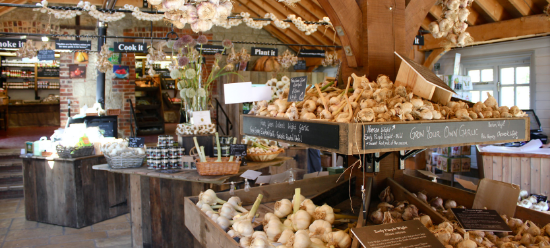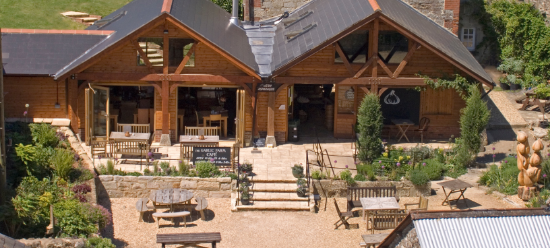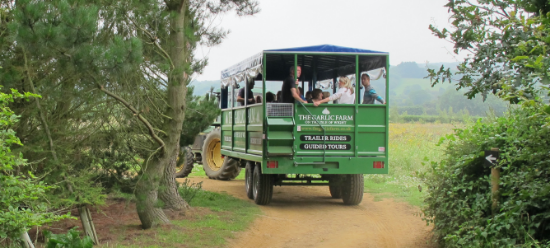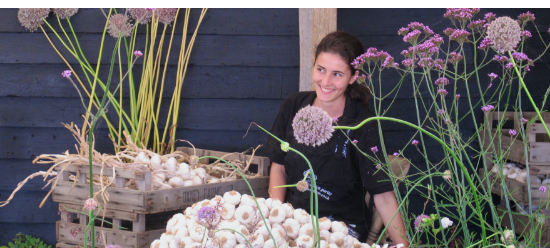Our top tips for growing great garlic
"Plant in Autumn from September to December - Plant in Spring, from January to late March ."
Check out the Garlic Farmers Calendar for a month by month guide on what to do and when.
Garlic grows across the UK provided it is grown in a free draining soil that is not too acidic, is kept well watered, weed free and has a good dose of both frost and sunshine. Any amateur gardener can grow good garlic.
For a great crop of garlic it is important to start with quality seed.
The Garlic Growers Calendar

Prepare soil for planting.
It is important for garlic to have free draining soil so as not to become water-logged as this can cause rot.
If you have heavy clay soil, you can dig in sand, grit and compost to improve its draning and fertility.
Choose a sunny position for your garlic. It likes full sun in spring and summer.
A no-dig method can be very effective for garlic. For more information on no-dig gardening see Charles Dowding

Autumn variety planting begins.
Follow planting instructions below.
Varieties to plant-
Softneck: Maddock, Rhapsody, Provence,
Hardneck: Extra Early, Kingsland, Carcassonne, Caulk, Elephant

LAST CHANCE FOR AUTUMN PLANTING VARIETIES.
Don't worry about your garlic being exposed to frost - it likes the cold at this time in the growing process.

Time to plant spring varieites. Follow below instructions to get your spring garlic types planted.
Spring planting:
Solent Wight, Mersley Wight, Picardy Wight, Elephant
Autumn planted garlic should be showing green tips.

Spring planting continues.
Apply garlic fertiliser or your own organic alternative

Spring planting continues.
Fertilise crop and weed where necessary.
LAST CHANCE FOR PLANTING SPRING VARIETIES

Weeding & Watering continue. Garlic needs plenty of water as the sun appears and bulbs grow to maximum size. Make sure not to leave the soil water logged though.
Harvest Green Garlic: Rhapsody Wight can be harvested early and used whole including green leaves.
Harvest Extra Early Wight toward end May. A very precocious variety which benefits from an early harvest.

Harvest time for most varieties. Garlic harvest 'rule of thumb' for softnecks, wait until stems are drooping, for hardnecks wait until most leaves have turned yellow/brown.
June: Extra Early Wight, Maddock Wight, Provence, Carcassone, Kingsland, Elephant Garlic
July: Caulk, Picardy, Mersley & Solent Wight

Once your garlic is harvested, lay out on a window sill or in a greenhouse for drying. Properly dried garlic will store for longer. This can take about 2 weeks, depending on the weather.
Plaiting or grapping your garlic is the best way to store garlic once dried. Learn how to plait your own garlic here: How to plait garlic video
Garlic Planting Guide
Prepare your soil well. Mix in lots of good compost long before you want to start planting. Make sure you have enough space (15cm between each clove - more for elephant). Plant in an area which will receive maximum sunlight hours. Good drainage is key.
Break the bulbs into cloves, leaving skin on. Place cloves 3 - 4cm below ground surface, root down (pointy end up), 15cm apart.


Water your garlic during dry periods throughout the growing season, but stop watering completely during the last few weeks. Carefully remove any weeds as they appear. From February, apply sulphate of potash to your garlic every 6 weeks to give it all the nutrients it needs to grow successfully.
Garlic will tell you when it is time to harvest. Too early and you'll miss the final growth spurt, too late and your bulbs will rot in the ground. When the garlic falls over and the leaves are brown, it's harvest time.
When to harvest Garlic in the UK
HARDNECK
Ready to lift when the lower leaves start to change colour from green to yellow/ brown. End of May - end July depending on variety.
SOFTNECK
When the lower leaves start to yellow and fold and the garlic goes “weak at the knees” and begins to lie on the ground. Mid May - mid August depending on variety.
Garlic Types
Elephant Garlic
Follow the same directions as for other garlic varieties, but increase spacing to 25cm. Plant from September.
Wild Garlic
Plant cloves 2-5cm deep, 25cm apart. Keep well watered the first year and do not pick any plants. Wild garlic seed heads should also produce viable seed and assist in the spread of your wild garlic area.
Rocamboles
Hardneck types produce beautiful floral spikes. These can be snapped off almost as soon as they appear to encourage the plants resources back down towards the bulb. Also known as scapes these can be sautéed and enjoyed like a garlicky green bean or asparagus or even made into a delicious pesto.
Hardnecks
Produce a hard flowering spike. Cloves form around a central stem. Varieties include: Lubasha Wight, Kingsland Wight, Caulk Wight. Typically planted in the Autumn for harvest end of June - July. Hardnecks are typically hardier when growing and stronger in flavour.
Softnecks
Produce a softer stem with no flowering spike, typically more cloves to a bulb, bunched together in tight circles. Varieties include: Rhapsody Wight, Provence Wight, Picardy Wight, Maddock Wight, Mersley Wight & Solent Wight. Typically easier to grow, with good keeping qualities.
Growing Garlic in Pots
Garlic can be successfully grown in pots. Use a fresh standard growing medium. Typically plant 3 cloves to a 15cm pot, 6 to a 20cm pot and 8 – 10 to a 25cm pot. Be sure to use pots with at least 15cm depth to allow adequate freedom for the roots. Keep well watered and stand outside on a patio or window ledge, in a good sunny position.
Common Problems and Diseases

Puccinia Porri: Small orange blisters can appear on the leaves of the plant from May onwards. Regular spraying or watering with sulphur compounds, will give some protection as will increased levels of sulphate of potash hoed in around the plants in February.

Presence is typically shown by growth halting and the neck of the plant thickening. The plant then dies. The onion fly lays its eggs close to or on the plant. When hatched the maggot (in appearance), bores into the bulb and it collapses. If plants die for no apparent reason, lift affected plants. Keeping the soil around the plants well cultivated from March - May will give some protection.

Occurs where there is a history of continuous garlic cultivation as it is soil borne. Plants fade away in April - June as bulbs become a white dust. As the disease progresses a white cottony fungal growth with black dots becomes visible. Destroy all infected material and do not grow alliums in infected area for at least 15 years.

Often mistaken for White Rot or Onion Fly, a few plants will fade April - June followed by more and more. It's a soil-borne nematode hosted by other garden plants. Any affected plants must be removed and destroyed. Do not add to garden compost. In order to avoid this problem repeating itself, rotate your garlic growing area and it may be necessary to leave the affected area fallow for at least three years, while not allowing anything to grow there that could host these pests.




















